
The ash borer, or lilac borer, is a clearwing moth in the family Sesiidae. It is found throughout North America and can be a pest of ash and lilac.
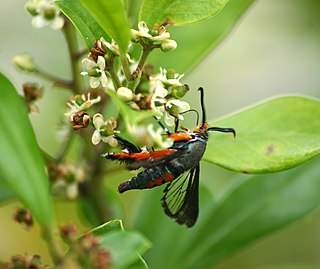
The squash vine borer is a diurnal species of sesiid moth. It is native to North America. The moth is often mistaken for a bee or wasp because of its movements, and the bright orange hind leg scales. The females typically lay their eggs at the base of leaf stalks, and the caterpillars develop and feed inside the stalk, eventually killing the leaf. They soon migrate to the main stem, and with enough feeding damage to the stem, the entire plant may die. For this reason, it is considered a pest that attacks cultivated varieties of squash, zucchini, pumpkin, and acorn squash. The squash vine borer is native to North America. It lives in most temperate North American states, except the Pacific coast. Southern states have two broods a year.

Phragmataecia castaneae, the reed leopard or giant borer, is a moth of the family Cossidae. It was described by Jacob Hübner in 1790. It is found in central and southern Europe, the Middle East, the Caucasus, Transcaucasia, Turkmenistan, Kazakhstan, north-western Iran, Iraq, Syria, Sri Lanka, Madagascar, India, Lebanon, Turkey, western China, south-western Siberia, Egypt, Tunisia and Morocco.
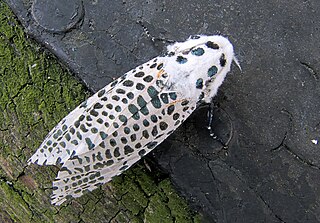
Zeuzera pyrina, the leopard moth or wood leopard moth, is a moth of the family Cossidae.

Amyna axis, the oriental eight-spot, is a moth of the family Noctuidae. The species was first described by Achille Guenée in 1852.

Penicillaria jocosatrix, the mango shoot borer, is a moth of the family Noctuidae first described by Achille Guenée in 1852. It is found from southeast Asia to the Pacific. Records include Borneo, Guam, Hawaii, India, Sri Lanka, Thailand and in Australia, Western Australia, the Northern Territory and Queensland.

Chilo suppressalis, the Asiatic rice borer or striped rice stemborer, is a moth of the family Crambidae. It is a widespread species, known from India, Sri Lanka, China, eastern Asia, Japan, Taiwan, Malaysia to the Pacific.
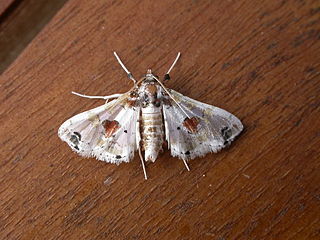
Leucinodes orbonalis, the eggplant fruit and shoot borer or brinjal fruit and shoot borer, is a moth species in the genus Leucinodes described by Achille Guenée in 1854. Its native distribution is in the tropical and subtropical parts of Australia and Asia, where it is recorded from Pakistan, Nepal, India, including the Andaman Islands, Sri Lanka, Bangladesh, Myanmar, Laos, Cambodia, Vietnam, Thailand, China, Taiwan, Japan, Malaysia, Singapore, Brunei, the Philippines, and Indonesia (Java). It has also been intercepted from fruit imports in the U.S.A., the Netherlands, Denmark and Great Britain, where it was also reported from the wild. A taxonomic revision of the Leucinodes species of Sub-Saharan Africa concluded that L. orbonalis is currently not present in Africa, and that previous records of this species were misidentifications of previously undescribed species.
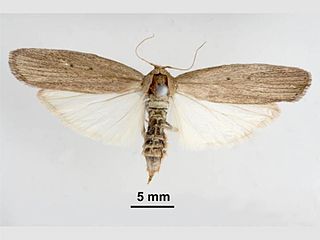
Eldana is a genus of moths of the family Pyralidae containing only one species, the African sugar-cane borer, which is commonly found in Equatorial Guinea, Ghana, Mozambique, Sierra Leone and South Africa. Adults have pale brown forewings with two small spots in the centre and light brown hindwings, and they have a wingspan of 35mm. This species is particularly relevant to humans because the larvae are a pest of the Saccharum species as well as several grain crops such as sorghum and maize. Other recorded host plants are cassava, rice and Cyperus species. When attacking these crops, E. saccharina bores into the stems of their host plant, causing severe damage to the crop. This behavior is the origin of the E. saccharrina's common name, the African sugar-cane borer. The African sugar-cane borer is a resilient pest, as it can survive crop burnings. Other methods such as intercropping and parasitic wasps have been employed to prevent further damage to crops.

Tirathaba rufivena, the coconut spike moth, greater coconut spike moth or oil palm bunch moth, is a moth of the family Pyralidae. It is found from south-east Asia to the Pacific islands, including Malaysia, the Cook Islands, the Philippines and the tropical region of Queensland, Australia. They are considered as a minor pest.
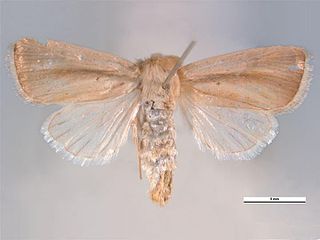
Sesamia inferens, the Asiatic pink stem borer, gramineous stem borer, pink borer, pink rice borer, pink rice stem borer, pink stem borer, purple borer, purple stem borer or purplish stem borer, is a moth of the family Noctuidae. The species was first described by Francis Walker in 1856. It is found from Pakistan, India, Sri Lanka, Myanmar to Japan and the Solomon Islands. A polyphagous species, it is a major pest in many crops worldwide.

Scirpophaga incertulas, the yellow stem borer or rice yellow stem borer, is a species of moth of the family Crambidae. It was described by Francis Walker in 1863. It is found in Afghanistan, Nepal, north-eastern India, Sri Lanka, Bangladesh, Myanmar, Vietnam, Thailand, Malaysia, Singapore, Sumatra, Java, Borneo, Sumba, Sulawesi, the Philippines, Taiwan, China and Japan.

Arctornis submarginata is a species of moth of the subfamily Lymantriinae of family Erebidae. It is found in the north-eastern Himalaya and Sikkim, Sri Lanka, on Borneo and Sumatra and in northern Australia.

Ostrinia furnacalis is a species of moth in the family Crambidae, the grass moths. It was described by Achille Guenée in 1854 and is known by the common name Asian corn borer since this species is found in Asia and feeds mainly on corn crop. The moth is found from China to Australia, including in Java, Sulawesi, the Philippines, Borneo, New Guinea, the Solomon Islands, and Micronesia. The Asian corn borer is part of the species complex, Ostrinia, in which members are difficult to distinguish based on appearance. Other Ostrinia such as O. orientalis, O. scapulalis, O. zealis, and O. zaguliaevi can occur with O. furnacalis, and the taxa can be hard to tell apart.
Indarbela quadrinotata, the bark-eating caterpillar, is a moth in the family Cossidae. It is found in India and Sri Lanka. It was described by Francis Walker in 1856.
Chilo auricilius, the gold-fringed rice stemborer or terai borer, is a moth in the family Crambidae. It was described by Gerald C. Dudgeon in 1905. It is found in India, Taiwan, Bhutan and Sri Lanka, as well as on Sulawesi, Borneo, Sangir Island and the Moluccas. The larvae bore into and feed on the stems of various grass family plants including sugarcane, rice and maize.
Chilo infuscatellus, the yellow top borer or sugarcane shoot borer, is a moth in the family Crambidae. It was described by the Dutch entomologist Samuel Constantinus Snellen van Vollenhoven in 1890. It is found in India, Myanmar, Tajikistan, Afghanistan, Korea, Taiwan, Malaysia, the Philippines and on Java and Timor.
Bissetia steniellus is a moth in the family Crambidae. It was first described by the British entomologist George Hampson in 1899. It is found in India and Vietnam where it is commonly known as the Gurdaspur borer because the larvae bore their way into and feed on the stems of sugarcane.
Cosmopolites sordidus, commonly known as the banana root borer, banana borer, or banana weevil, is a species of weevil in the family Curculionidae. It is a pest of banana cultivation and has a cosmopolitan distribution, being found in all parts of the world in which bananas are grown. It is considered the most serious insect pest of bananas.















